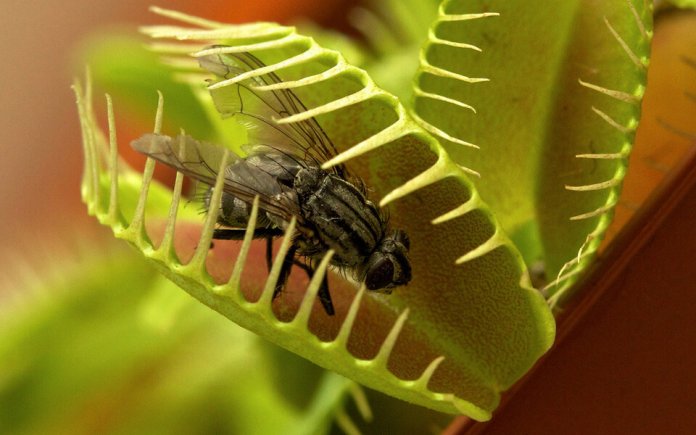Scientists know more than two hundred species of fungi and six hundred species of plants that are capable of attacking, killing and devouring insects, worms and even small amphibians and birds. Why? They just want to get the nutrients they need, especially nitrogen. Introducing top 7 carnivorous plants and mushrooms, luring and mortifying their victims in ways that would be the case in a horror movie.
7. Nepentes Attenborough
The shape resembles a huge jug (or toilet bowl), equipped with a hinged lid on top. From the inside of the lid, the plant secretes sweet nectar that attracts tupai, small mammals. They lick the nectar and shit in a jug, and the contented plant processes feces, getting from them the nitrogen and phosphorus it needs.
6. Predatory mushroom
Three cells on a special hypha of this insectivorous fungus from the genus Dreschlerella anchonia form a tiny circle (0.03 mm in diameter). If the nematode worm touches a sensitive strip on the inner wall of the ring, the ring thickens three times in tenths of a second and captures the victim. Then, special hyphae emerge from the walls of the ring, which penetrate inside it, release digestive enzymes inside and begin the digestion process.
5. Pemphigus
The leaves of the plant are a kind of balls, the only hole in which is closed by a valve. The edges of the hole are coated with a water-repellent substance, which also contains sugar compounds that attract insects. When an unwary insect touches the sensitive hairs on the valve, it quickly opens and the victim, along with the stream of water, is rapidly carried inward, and the valve also slams instantly. The plant only needs to digest the food. However, some species of pemphigus have abandoned their predatory lifestyle, leaving their bubbles for living for algae and zooplankton.
4. Zhiryanka
These plants catch their victims with the analogue of duct tape. Their wide leaves are covered with tiny hairs, and many glands on them secrete sugary mucus that lures insects. The insect sits on a leaf, gets bogged down in mucus and tries to escape. The plant senses these movements and begins to slowly roll the leaf, while other glands begin to secrete digestive enzymes. The end is predictable.
3. Dewdrop
The leaves of the plant are covered with many villi with liquid droplets at the tips. Insects land on leaves to sample the tempting gleaming nectar, and get bogged down in the gooey substance. The leaves bend to cover their entire prey. All this happens very slowly, the process can take several hours, but the victim is paralyzed by the alkaloid contained in the liquid and can no longer escape. The leaves then release enzymes that slowly digest the victim. In this case, the sundew needs pollination in order to continue the genus, so the flower itself with real nectar is on a long stem. This is to prevent pollinating insects from being trapped.
2. Sarracenia
The plant resembles flowers that attract insects in shape and color, but the upper part of the leaves forms a long, narrow container.The edges of the "jug" are covered with a slippery, wax-like substance, along which an unwary insect slides down into a liquid, which is a mixture of active substances. Its wings get wet, it sinks and sinks to the bottom, and there it is slowly digested.
1. Carnivorous bromeliads
The leader of the rating of predatory fungi and plants is a representative of the family of tropical plants, which include the harmless pineapple. In some bromeliads, leaf sinuses form a kind of jugs full of liquid, and the leaves themselves are covered with a layer of a substance that reflects ultraviolet light and attracts bees and other insects that are sensitive to it. Bromeliads also secrete nectar-like compounds. Insects land on an unstable, powdery surface, lose support and sink into the liquid, where they are digested by enzymes secreted by the plant and bacteria living there.

